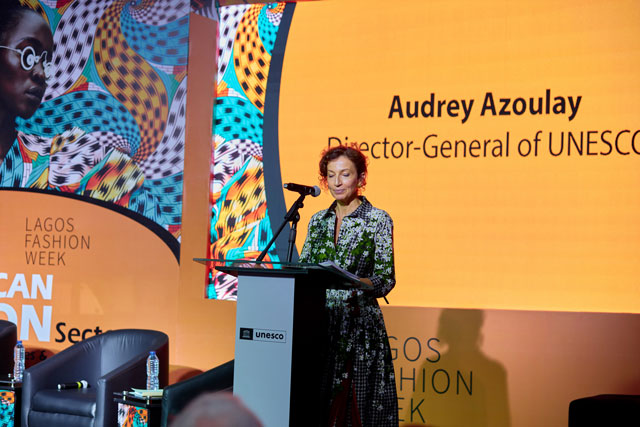
A growing, worldwide interest in African cultural and fashion events supports the findings of a new report showing that Africa holds all the cards to become a global leader in fashion.
SPECIAL REPORT | BIRD AGENCY | Africa’s young, innovative, and growing population, a rising middle class, rapid urbanization, and increased government support are some of the factors fueling the African fashion sector, according to a new UNESCO report.
The report, ‘The Fashion Sector in Africa: Trends, Challenges, and Opportunities for Growth,’ unveiled on October 26 during the 13th edition of the Lagos Fashion Week, shows that “the continent holds all the cards to become one of the next world fashion leaders.”
“The potential is enormous, not only for the economy but also for young people’s inclusion, women’s empowerment, and for African culture to resonate globally,” Audrey Azoulay, UNESCO Director-General explains in the press statement accompanying the report.
The bulk of African fashion businesses are micro, small, and medium enterprises (MSMEs), targeting a hyper-local market with ready-to-wear and made-to-order clothes.
However, there is a growing number of high-fashion brands concentrated in key markets such as Côte d’Ivoire, Ghana, Kenya, Nigeria, Rwanda, Senegal, and South Africa. These provide luxury products for a small group of local and international clients with high purchasing power.
Last year, the overall luxury goods market was estimated to have generated nearly 6 billion dollars in revenues in Africa—a number that has been growing year on year. A fifth of this income was fueled by high fashion, a market that is expected to grow annually by 0.79% from 2023-2028.
The sector holds immense potential, according to the report, and can be leveraged to draw extensive economic gains for African designers, stylists, and fashion creators.
Africa is a major producer of fashion raw materials, with 37 out of 54 countries producing cotton. Textile exports from the continent average US$15.5 billion a year.
Benin, for example, is the largest cotton-producing country in Africa, with fabric contributing between 12 and 13% of GDP. Wool, another textile and fashion raw material, is produced in significant quantities in southern and northern African countries. Silk is also available in Madagascar, Ethiopia, Namibia, and South Africa.
Artisanal fibres such as raffia are produced in Cameroon, the Congo, Côte d’Ivoire, the Democratic Republic of the Congo, Liberia, Madagascar, and Nigeria, while tree bark is used in Côte d’Ivoire, Ghana, and Uganda.
The continent also produces a wide variety of lesser-known, yet highly sustainable fibres, such as jute, kenaf, coir, flax, sisal, ramie, kapok, and abaca, which are now in demand with emerging designers seeking sustainable and local materials as the global fashion industry seeks to cut 30% of its emissions by 2030, with 2015 as the base year.
There is also a growing consumer demand trend for fashion made in Africa, especially among young people, under-25s, who make up more than 35% of the population.
This growing demand is exemplified by the rise in fashion exhibitions across major cities as designers, stylists, and sector entrepreneurs seek to show the best of their designs in a bid to tap investments. The UNESCO report estimates that about 32 fashion weeks are held annually in Africa.
Between October 25 and 29, fashion designers pitched tent in Nigeria for the Lagos Fashion Week, one of the largest fashion exhibitions on the continent, with this year’s edition featuring close to 50 runway performances and shows.
Renowned African designers ranging from Ivorian designer Artistide Lour of Kente Gentleman to Kenya’s Lilabare, among others, joined returning exhibitors such as Elie Kuame and Orange Culture to parade the best of African fashion.
Omoyemi Akereke, the founder and CEO of Lagos Fashion Week, explained to the researchers of the UNESCO report the fast-changing trends among African consumers.
“It’s really beautiful to see because it hasn’t always been like this. When we launched Lagos Fashion Week, we had to create a campaign around “Buy Nigerian” and “Buy African” to encourage people to start buying Nigerian or African. But fast forward a decade later, and that’s all people want to wear,” she explained.
However, while the growing demand locally is undoubtedly rising, affordability challenges limit full economic returns. This compels designers and stylists to export raw or semi-processed designs and later import processed and finished wears and designs.
Africa’s textile imports, including clothing and footwear, are valued at US$23.1 billion annually, almost double the value of exports. However, different country-level initiatives have been launched in key markets and are on course to impact the sector in the future.
From setting up textile processing plants such as the Glo-Djigbe Industrial Zone in Benin, projected to process more than 18 million round and polo shirts, to the proposed Funtua integrated textile and garment park (ITGP) in Nigeria, these initiatives could transform the historical cottage industry into a high-end local processing industry that will catalyze fashion uptake.
National governments, realizing the immense potential of the sector, have also increased support for its development.
Some countries, such as Ghana, Lesotho, Kenya, and Malawi, are encouraging their citizens to wear locally-made creations, while “in Cote d’Ivoire, a ‘Local Wear Day” for civil servants focuses specifically on traditional woven fabrics,” the report explains.
Others are organizing trade shows, bringing together sector players, and promoting shared partnerships. The “Africa Sourcing and Fashion Week,” an annual event in Addis, is one such example. Others, such as the “Morocco Yarn and Fabric Sourcing Show” and “Togo’s International Fair for African Textiles”, complete the long list of similar initiatives.
There is also a growing interest among private sector players, with global fashion brands now flocking to the continent, seeking to be part of the fast-growing industry and market. Ethiopia, for instance, boasts of hosting more than 100 garment industries controlled by Chinese, Indian, and Turkish investors.
Recently, H&M and Levi’s, reputable global labels, have set up manufacturing facilities in the Eastern African country, relocating from China.
fashionrevolution.org explains that investors are attracted especially to Ethiopia because of its rare historical expertise in its designs, such as the handwoven Ethiopian textiles cemented by favourable economic conditions in the country.
Senegal is also thriving both in its domestic and foreign fashion industries. Domestically, the West African country has produced world-renowned labels such as Tongoro, Selly Raby Kane, Diarrablu, and Adam Paris. Foreign brands such as Levi’s, Tommy Hilfiger, and Hugo Boss have also recently trooped to Dakar.
The fashion industry globally is expected to double in the next 10 years, generating up to US$5 trillion annually.
However, as renowned Nigerian fashion designer Sidahmed Seidnaly underscores, for Africa to ride on this trend, there is a need to build capacity around intra-African supply chains to stabilize the sector.
“Africa should have the capacity to industrially produce textiles. It is difficult to make ready-to-wear collections with these constraints. Our fashion remains reserved for a minority because of production costs,” he explains.
*****
SOURCE: Bonface Orucho, bird story agency
 The Independent Uganda: You get the Truth we Pay the Price
The Independent Uganda: You get the Truth we Pay the Price



